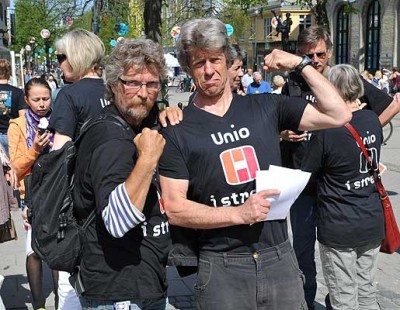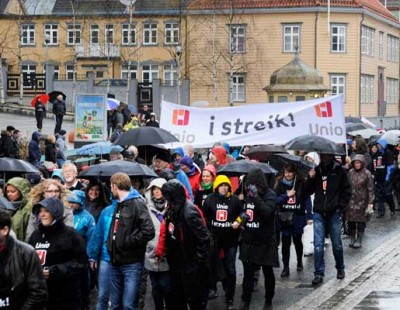Striking public sector workers all over Norway claimed their fighting spirits were high as they launched into the country’s first major strike involving state workers since 1984. The unions represent around 600,000 workers in Norway and union leaders warned the strike will spread early next week.

Another 16,000 strikers will likely join the roughly 26,000 public sector workers who were pulled off the job on Thursday. Leaders of the trade union confederations behind the strike – known as LO, Unio and YS – said that at least 15,000 members of the union Fagforbundet won’t show up for work when Norway’s upcoming three-day pinse holiday weekend ends on Tuesday. An additional 500 members of YS, which represents a wide range of state and municipal workers, will be pulled off their jobs as well.
“We haven’t used our right to strike for 28 years,” a so-called union “elder” in YS Stat, Pål Arnesen, told members who had donned strike vests to protest outside state tax offices in downtown Oslo. “But why should state employees be denied wage growth that everyone else is getting? Why isn’t your contribution, competence and experience valued in the same way as other employees? This is worth going out on strike for.”
The strike in selected townships from Tromsø in the north to Kristiansand in the south began early Thursday after talks broke down between negotiators for the public sector workers and their employers. State officials including Prime Minister Jens Stoltenberg, who also funnel funding to the townships, claim they made a good offer that they now calculate as a pay raise of 3.75 percent. The unions demanded at least 4.5 percent and the main point of contention is over how the pay hikes should be calculated.

Both government and union negotiators are arguing over the size of raises won by workers within industries that negotiate their wage agreement first, when annual talks get underway in the late winter and early spring. These industries are referred to as frontfag, a buzzword that’s at the core of the current dispute because negotiators for the state and the unions don’t agree on which raises for which workers within the frontfag industries – selected as construction, shipyards and textile in 2004 – should be included. Newspaper Aftenposten reported that the unions include engineers and other white-collar-type workers in the equation, while the state includes mostly blue-collar workers, and their raises differed not least because of the current demand, for example, for engineers. That explains the difference in the pay raise offer by the state and the pay raise demand by the unions, and not even the state mediator could resolve that difference and head off the strike.
YS leader Tore Eugen Kvalheim, writing in newspaper Dagsavisen on Friday, claims the state “forced” the unions out of strike. “We’re striking so that public-sector employees won’t have weaker wage development than the rest of society,” he wrote. He claims the unions’ demands are “reasonable and realistic,” calling the state’s offer “shameful.” Kvalheim and other union leaders want public sector workers to have pay raises comparable to those in the private sector. There was no mention, though, of the better job security and pensions that public sector workers generally enjoy.
The situation seemed deadlocked after Stoltenberg indicated his government was holding firm on its offer. He claimed the workers’ expectations, like those of the farmers in another recent conflict, were too high, and that no workers should get carried away with wage demands despite Norway’s strong economy.
Sentiments on both sides are likely to change if the strike drags on. With many schools and day care centers closed, nursing home and health care services curtailed, and a wide range of community services disrupted from garbage collection to police investigations, the pressure will build for a solution. Some unions were still negotiating, including those in Oslo.
Views and News from Norway/Nina Berglund
Please support our stories. Readers in Norway can use our donor account. Our international readers can click on our “Donate” button:

